Globalization is changing cities at a staggering pace, and at the same time cities face enormous competition for people, goods, and capital. With this intense global competition, it is incredibly important for cities to construct an effective “city image” in order to remain distinct and competitive, and thus attract resources. Through a survey and analysis of the perceptions of over 2,000 respondents in 40 global cities, this study aims to not only help understand the image of cities, but to also contribute to the future branding strategies of 8 target cities: London, New York, Tokyo, Paris, Singapore, Seoul, Hong Kong, and Shanghai.
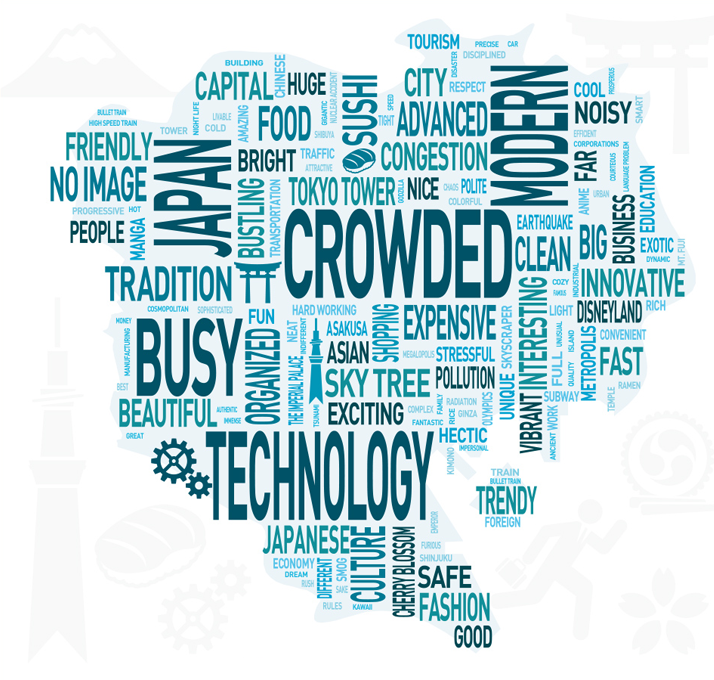
Keyword Ranking

In contrast to Tokyo's impression as CROWDED, the world's most populated city is also recognized as being ORGANIZED efficiently, and has an image of TECHNOLOGY and MODERN advancement. For landmarks, the city receives responses for SKYTREE and TOKYO TOWER, although only from residents in Japanese cities. The overall perception of Tokyo is as an efficient and advanced metropolis, though landmarks are not well-recognized internationally.
Visitor/Non-Visitor Analysis

Those respondents who had not actually visited the city described Tokyo as a STRESSFUL and NOISY city, suffering from POLLUTION. These largely negative perceptions are associated with typical traits of any sprawling, developed city with a large population. Those with first-hand experience in the city, however, mentioned more favorable terms such as SAFE, POLITE and CLEAN. These latter impressions may represent the aspects of the everyday life in Tokyo only noticeable through close observation.
Location-specific Analysis
【How the world sees Tokyo】
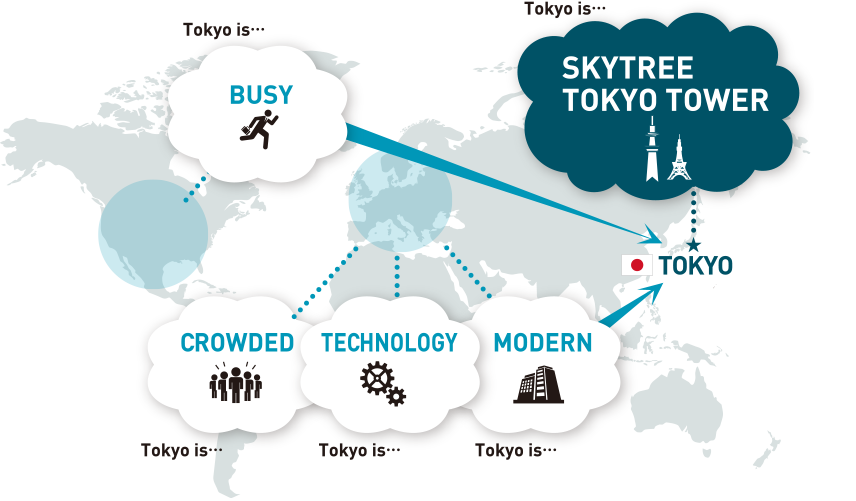
Respondents from cities in Europe and America regard Tokyo as CROWDED and BUSY in their observations. From Asia, people mentioned words like FASHION and ADVANCED. TECHNOLOGY and MODERN are also common responses from cities in these two regions. Alternatively, SKYTREE and TOKYO TOWER are almost exclusively mentioned by respondents in Japanese cities—indicating the lack of global awareness of the two structures as a symbol of Tokyo.
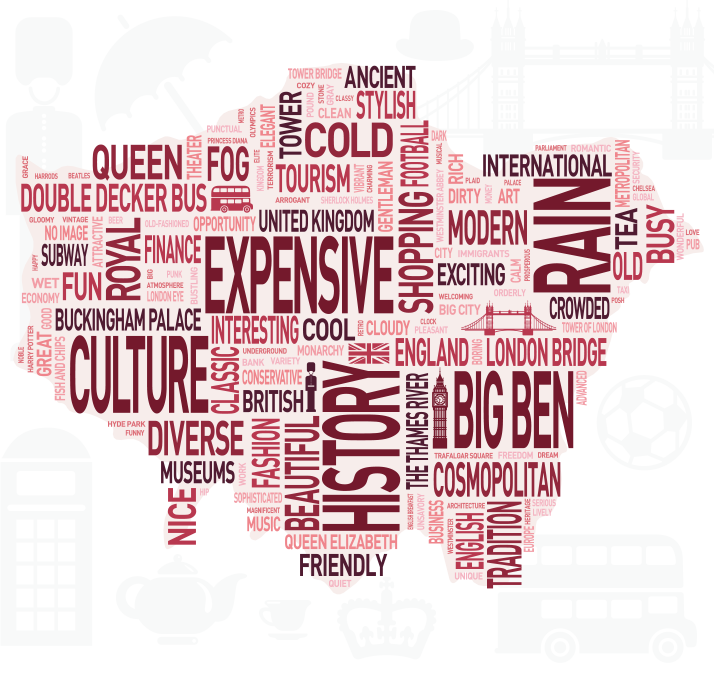
Keyword Ranking

Having a long history, London is associated with keywords like HISTORY, and TRADITION, while at the same time being considered a multicultural city, evident in words like COSMOPOLITAN and DIVERSE. Furthermore, a wide range of landmarks like BIG BEN and DOUBLE DECKER BUS are also associated with London. While weather-related words like RAIN, FOG, and COLD are frequently mentioned characteristics for London, these responses are strongly associated with non-visitors. By integrating these various responses, London's overall image is a global city with somewhat gloomy weather, but brimming with landmarks, and possessing a unique history and tradition.
Visitor/Non-Visitor Analysis
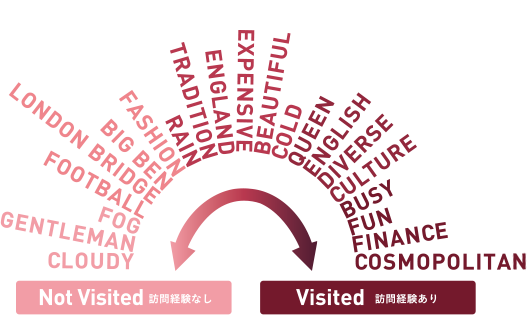
Many non-visitors tend to associate strongly with the city’s weather, providing keywords such as CLOUDY and FOG. In addition, the traditional English concept of the GENTLEMAN, as well as globally recognizable tourist attractions, likeLONDON BRIDGE and BIG BEN, are mentioned most often by non-visitor respondents. In contrast, specific vocabulary that are often used to describe a large, global city such as DIVERSE, BUSY, and COSMOPOLITAN are more likely to find usage among experienced visitors. They also frequently referred to words associated with its rich cultural and lifestyle qualities, such as CULTURE and FUN.
Location-specific Analysis
【How the world sees london】
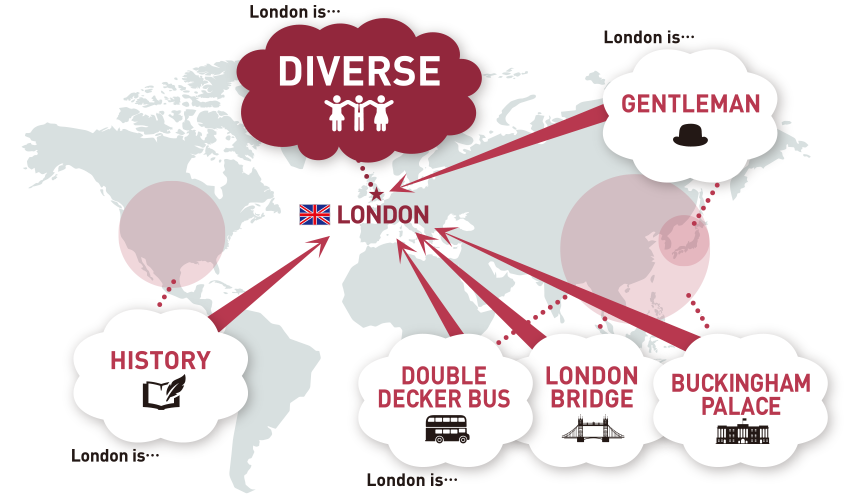
Many residents of North America possess a strong image of HISTORY for London, which may reflect the historical connection observed between London and both the USA and Canada. In contrast, residents representing Asian cities gravitate towards famous landmarks such as LONDON BRIDGE, and BUCKINGHAM PALACE. The traditional image of the GENTLEMAN is a response originating exclusively from people in Beijing, Shanghai, Taipei, Tokyo, and Osaka. DIVERSE is a perception primarily held by Londoners, clearly indicating the demographic and cultural environment experienced by residents in their own city. However, climate-oriented words, like RAIN and FOG are completely absent from Londoners’ responses.
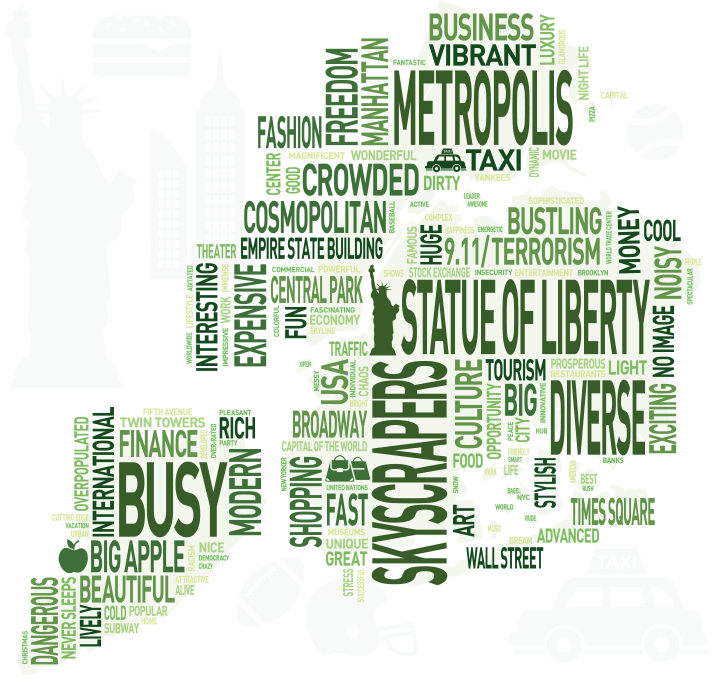
Keyword Ranking

New York displays symbols of its urban power through keywords like SKYSCRAPERS, METROPOLIS, DIVERSE, COSMOPOLITAN, and BIG, while also being associated with a restless atmosphere through the words BUSY, CROWDED, and FAST. Other impressions include BIG APPLE (nickname), TIMES SQUARE, and BROADWAY, which are linked to the city's landmarks. Through these perceptions, New York presents itself as a world city always in motion with urban activity, and filled with diverse cultural energy.
Visitor/Non-Visitor Analysis
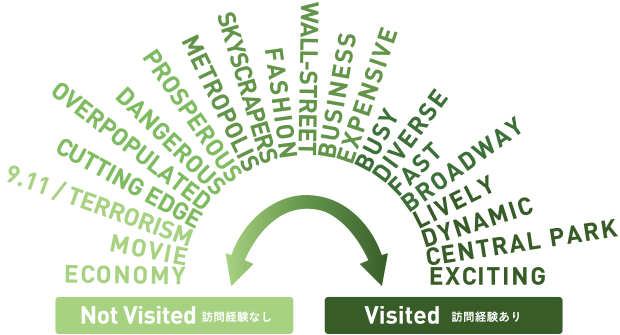
Regarding New York, broad and globally familiar terms rank higher in frequency for non-visitors, evident in responses such as ECONOMY, MOVIE and 9.11/TERRORISM. Also mentioned by non-visitors is OVERPOPULATED, referencing the crowded image of the city. Respondents who had visited New York, described the urban lifestyle with relatively positive adjectives such as EXCITING, LIVELY, FAST, DIVERSE, and DYNAMIC being recorded. CENTRAL PARKand BROADWAY are also noted by a large ratio of visitors.
Location-specific Analysis
【How the world sees newyork】
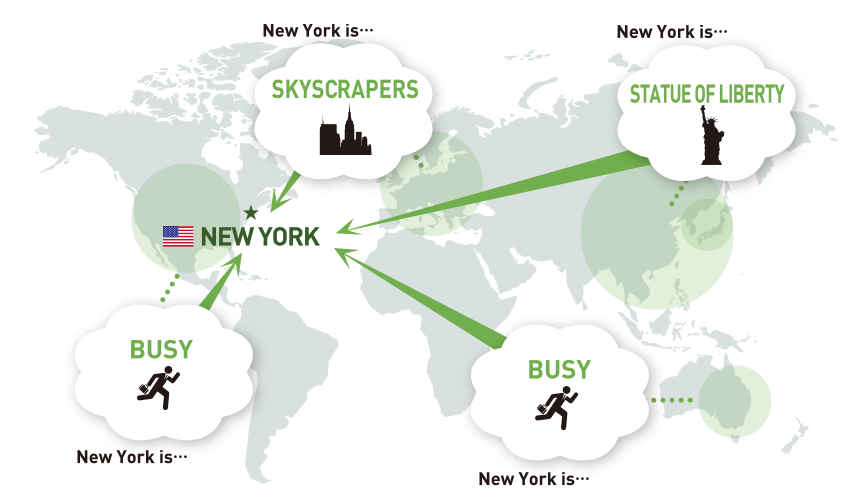
Respondents in parts of Asia, and especially Japan, focus primarily on New York City’s iconic landmark, the STATUE OF LIBERTY. In Europe, where there are comparatively fewer tall buildings, SKYSCRAPERS is answered more frequently. Conversely, for respondents in major cities in Asia—like Beijing, Hong Kong, Shanghai and Taipei—responses for SKYSCRAPERS occur less frequently. Many respondents in North America, especially those in Toronto, Vancouver and Washington, DC described New York city as BUSY.
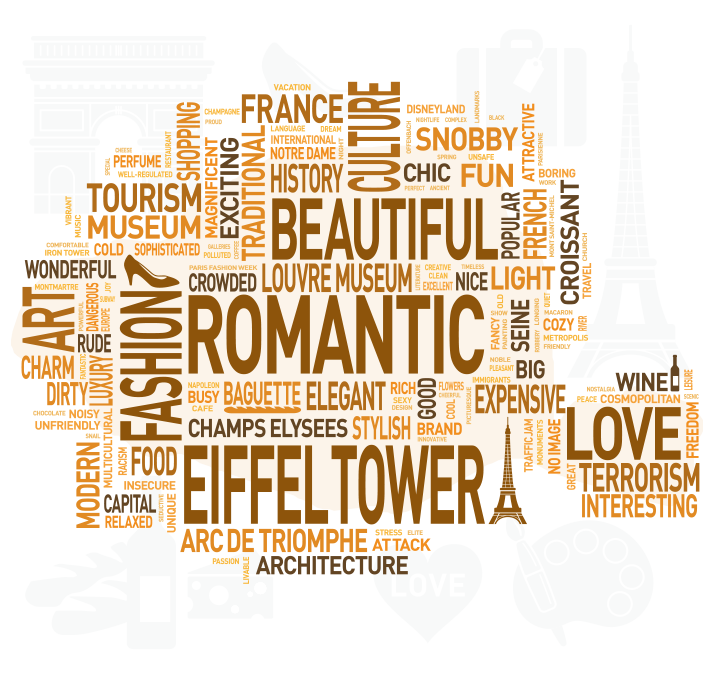
Keyword Ranking

With keywords strongly connected to themes of culture and love, Paris displays the most unique image among the target cities. Also, Paris is the only target city where the top ranked keyword is represented by a landmark, indicating how widespread the global awareness is for the EIFFEL TOWER. Other places like the LOUVRE MUSEUM and the ARC DE TRIOMPHE are likewise associated with the city, regardless of whether respondents had visited or not. Although the image of Paris is overwhelmingly positive, perceptions differ depending on the region. Respondents from Asia tend to use the word ROMANTIC, while those from the United States mention BEAUTIFUL. European respondents used keywords like LOVE and CULTURE. In all, Paris represents an image of impressive landmarks and beautiful scenery, as well as being a romantic city full of love and culture.
Visitor/Non-Visitor Analysis
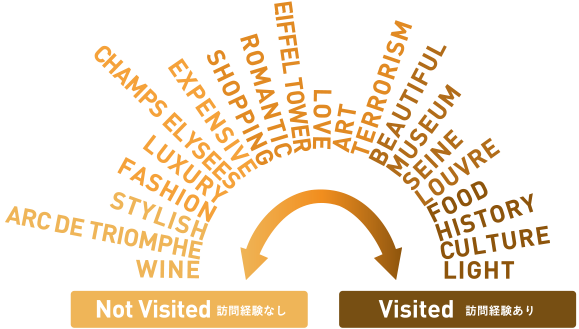
Non-visitor suggested an image of fashion culture, with keywords such as STYLISH, FASHION, and LUXURY. The city’s landmarks, such as ARC DE TRIOMPHE, EIFFEL TOWER, the LOUVRE, and the SEINE are equally distributed among all respondents, reflecting the level of world recognition that Paris’ famous sights possess. On the other hand, visitors to Paris do hold somewhat different opinions more focused on the cultural aspects of the city, as words like LIGHT, CULTURE, and HISTORY are revealed from their responses.
Location-specific Analysis
【How the world sees paris】
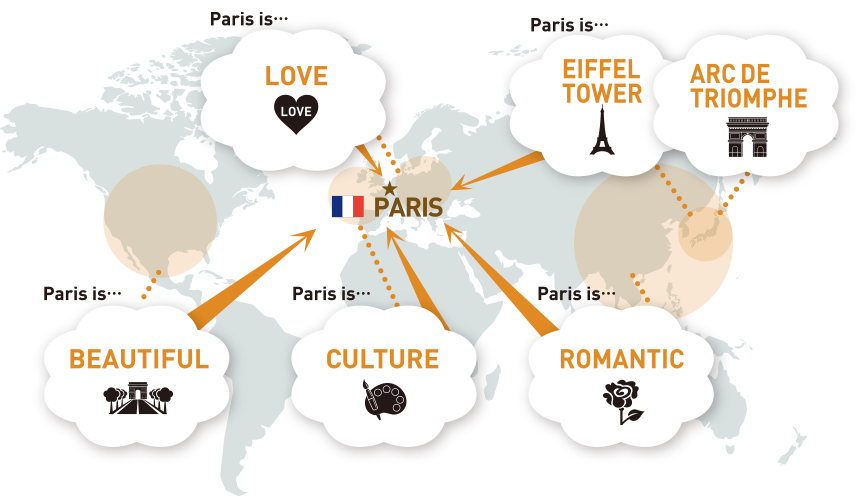
The primary image associated with Paris is connected to themes of beauty and love. Respondents in North American cities frequently describe Paris as BEAUTIFUL. In Europe, respondents from cities within German-speaking areas use the word LOVE, while those from other regions mostly respond with CULTURE. From the perspective of residents in Asian cities, ROMANTIC is the overall image held for Paris. This, however, is not the case in Japan, where respondents cite images based around architecture and iconic structures, such as EIFFEL TOWER and ARC DE TRIOMPHE, while providing very few responses for ROMANTIC and LOVE.
PUBLICATIONS
To purchase the report of the CITY PERCEPTION SURVEY Index, please click on “Go to Publication”. A preview version is available below.



